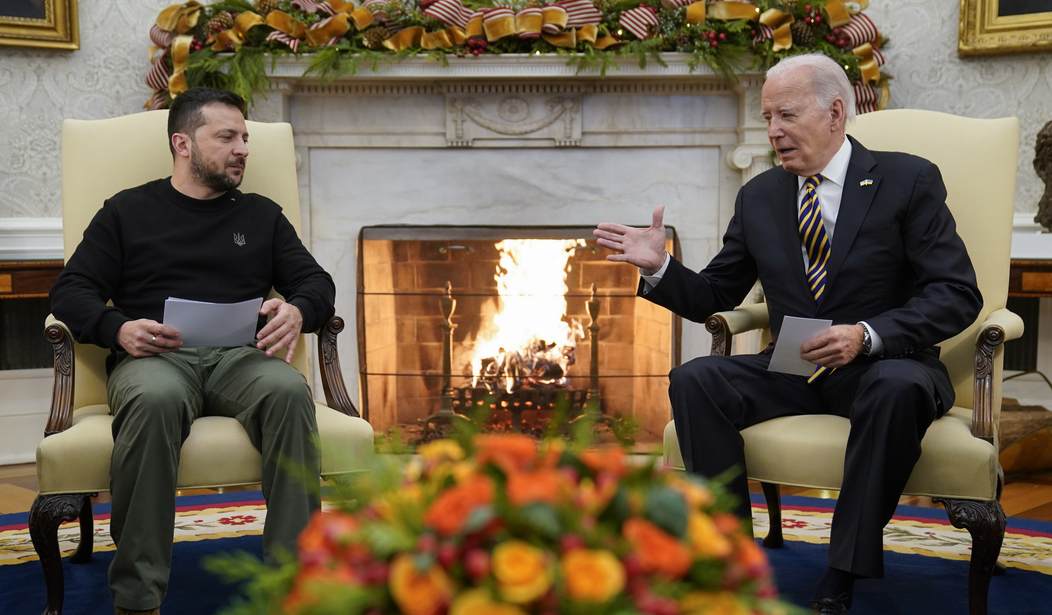The war between Russia and Ukraine is currently at a stalemate. Kyiv's much-publicized offensive over the summer failed to take much territory, and Ukraine lost a lot of Western-supplied equipment that was supposed to give Kyiv a decisive advantage.
As it turned out, Russia's defensive fortifications proved difficult to crack even with the upgrade in tanks, artillery, and drones. Russia is now carrying out a psychological offensive, hitting the electrical grid and other infrastructure targets that diminish the quality of life and put fear in the minds and hearts of the population.
The question for Ukraine's President Volodymyr Zelenskyy and his military leaders is where to go from here. In their heart of hearts, they must know that they will not be able to reclaim the 20% of Ukraine that Russia has stolen since 2015; at least, not in the near future.
Joe Biden must now convince Zelenskyy that he should recalculate his goals for the war and get as much as he can in hopes of showing Russian President Vladimir Putin that any attempt by Moscow to take most of Ukraine's territory is a fool's hope.
Recent reports that Ukraine is in danger of falling to Russian forces are scare tactics to get the aid package unstuck in Congress. Russia doesn't have that kind of offensive power anymore, and Ukraine still has considerable defensive firepower to counter Moscow.
The CIA believes that the Russian military has suffered severe losses since the war began.
Since the beginning of the war Russia has suffered from a staggeringly high number of losses, according to another newly declassified assessment shared with Congress. At the start of the war the Russian army stood at 360,000 troops. Russia has lost 315,000 of those troops, forcing them to recruit and mobilize new recruits and convicts from their prison system.
Moscow’s equipment has also been crushed, according to the assessment. At the start of the war, Russia had 3,500 tanks but has lost 2,200, forcing them to pull 50 year old T-62 tanks from storage.
Russia has also been forced to buy ammo from North Korea, as well as some old 55mm guns. It has also been forced to draft convicts to fight in the trenches.
But Russia has vast stores of manpower to draw on. And it turns out that Iranian drones that Putin bought in great numbers are making a difference on the battlefield. Russia is far from being finished and has only scratched the surface of its resources to fight.
While Zelenskyy wants Ukraine to remain offensive-minded, Biden and the Americans have been trying to convince him to regroup his forces and prevent Russia from making any more gains. Putin has made it clear that he will go on the offensive in order to achieve his war aims.
Zelesnkyy's desire for a more offensive war is going to run into the reality that not only the U.S. is reluctant to fund the war, but the EU is also having trouble with commitments it has made.
Western Europe’s support is also less than solid. Hungary is poised to veto an E.U. aid package, and Germany’s government is struggling to fund its own pledge. “Some senior European defense officials quietly acknowledge that the weapons and ammunition that Europe is currently sending to the war can’t match what Ukraine is burning through,” my colleague Lara Jakes, who is reporting the story from Europe this week, told me. “That means Ukraine could run out of some weapons early next year if the United States fails to approve the additional aid.”
As Matthew Kaminski writes in Politico, “Putin thinks the West is dissolute and will come apart on its own.”
The fact is that most European and American officials realize that Ukraine is going to come up far short of total victory against Russia. That means a negotiated settlement. And that means that Russia maintains control of sizable portions of Ukraine's territory.
That might not be satisfactory for Zelenskyy. But he should count his blessings. Ukraine would still be a viable nation with powerful allies and the probability that it will join NATO.
Given the circumstances, it could have been far worse.










